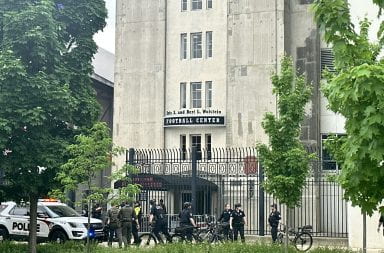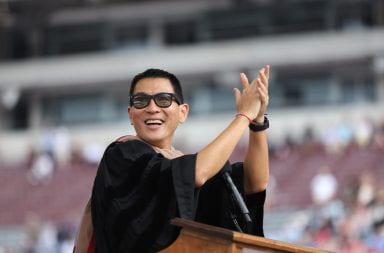If there is one word that can describe the entire student population at Ohio State, that word is diverse. The university prides itself on having people with different backgrounds and experiences. In order to fairly represent this in the Undergraduate Student Government, students need a president and vice president with a wide range of knowledge and experiences.
The time of year has come for every OSU student to voice his or her opinion on who next year’s USG leaders should be. Voting starts today and runs through Friday. There is one candidate team that rises above the rest in diverse knowledge and experiences. Ryan Jolley and Kara Silverman have been involved with a number of university and non-university activities. This has put them in contact with different types of students and has presented them with a number of issues. By putting their experiences together, Jolley and Silverman have had substantial outreach with off-campus students and dormitory residents, OSU alumni, honor students and the Jewish community.
The Jarrod Weiss/James Conway team and the Aftab Pureval/Deb Mason team both have substantial experience in OSU activities. Combined, they have tallied multiple involvements in the university, but fail to go beyond OSU. Being the youngest candidate team, Elizabeth Ghandakly and Geoffrey Moes lack experience both within OSU and outside of it.
With his experience as a school board member and part of a statehouse representative’s staff, Jolley provides insight of the Ohio government and its effects on OSU, as well as the knowledge of planning out a school budget. Silverman has worked as part of USG’s Governmental Relations committee, which has met and lobbied with Congressional leaders.
One of the issues on most high school and college students’ minds is the increasing costs of tuition. There is little USG can do to alleviate this concern unless it is willing to go outside of university authorities. Many of the presidential team candidates have offered to lower or stabilize tuition costs, but they do not address the way to go about doing so. In addition, most of the candidates do not have the connections to effectively deal with the Ohio government. By gaining experience with government officials, Jolley and Silverman have the edge over the other candidates in alleviating the tuition problem. They have made it clear that this issue is at the forefront of their minds. Unlike other platforms, the Jolley/Silverman platform emphasizes not only that tuition should not continue to increase, but that the money students are spending should be put in the right place.
In the past, USG has failed to communicate with and represent the entire undergraduate population. Many students are unsure of what USG is and what it does. Jolley and Silverman recognize this as being the biggest problem with the current USG structure. By accepting this flaw, Jolley and Silverman can move toward allieviating the problem. They want the entire undergraduate student body to feel it has a voice in its government. When students do not know what USG is or what it is doing, though, it is tough to have an impact on the government. The Jolley/Silverman platform intends to open up channels of communication with OSU students.
Other candidate teams expressed a lack of communication as a problem as well. The Weiss/Conway team did not present a way to fix the problem while the Pureval/Mason team wanted to hold “town meetings.” Jolley and Silverman want to attend freshman survey courses to get students involved from the start. They also said if they can meet 1,000 constituents a day while campaigning, there is no reason they cannot continue to go out and meet more after being elected. By attending the survey courses, Jolley and Silverman will address more students than by simply holding “town meetings.” Students often feel a higher obligation to attend class than voluntary meetings.
It is Jolley and Silverman’s focus and realistic goals that will allow them to steer USG in the right direction. The Weiss/ Conway team lacks focus – it has plenty of ideas but is not concentrated on finding a way to make them work. Weiss and Conway have not presented an order of importance in issues, thus making providing better food in the commons and parking as important as increasing tuition and safety.
The team of Jolley and Silverman has a vision and sees the way to create that vision. This is where Ghandakly and Moes fall in the race. Having not been around OSU as long as the other candidate teams, Ghandakly and Moes are not clear on the direction USG needs to take to create a better atmosphere for the undergraduate student population as a whole. Experience with a number of student and non-student groups has allowed Jolley and Silverman to see the problems students and surrounding community members have with OSU. This has allowed them to put forth a direct plan with a detailed route.
Jolley and Silverman have labeled specific ways to work out the problems they have presented. The Pureval/Mason team slips below the Jolley/Silverman team in this respect. While Pureval and Mason have envisioned a place for their efforts and focus, they have failed to map out a path to get there. By creating a path, Jolley and Silverman will be able to get more done in their tenures as USG president and vice president.


